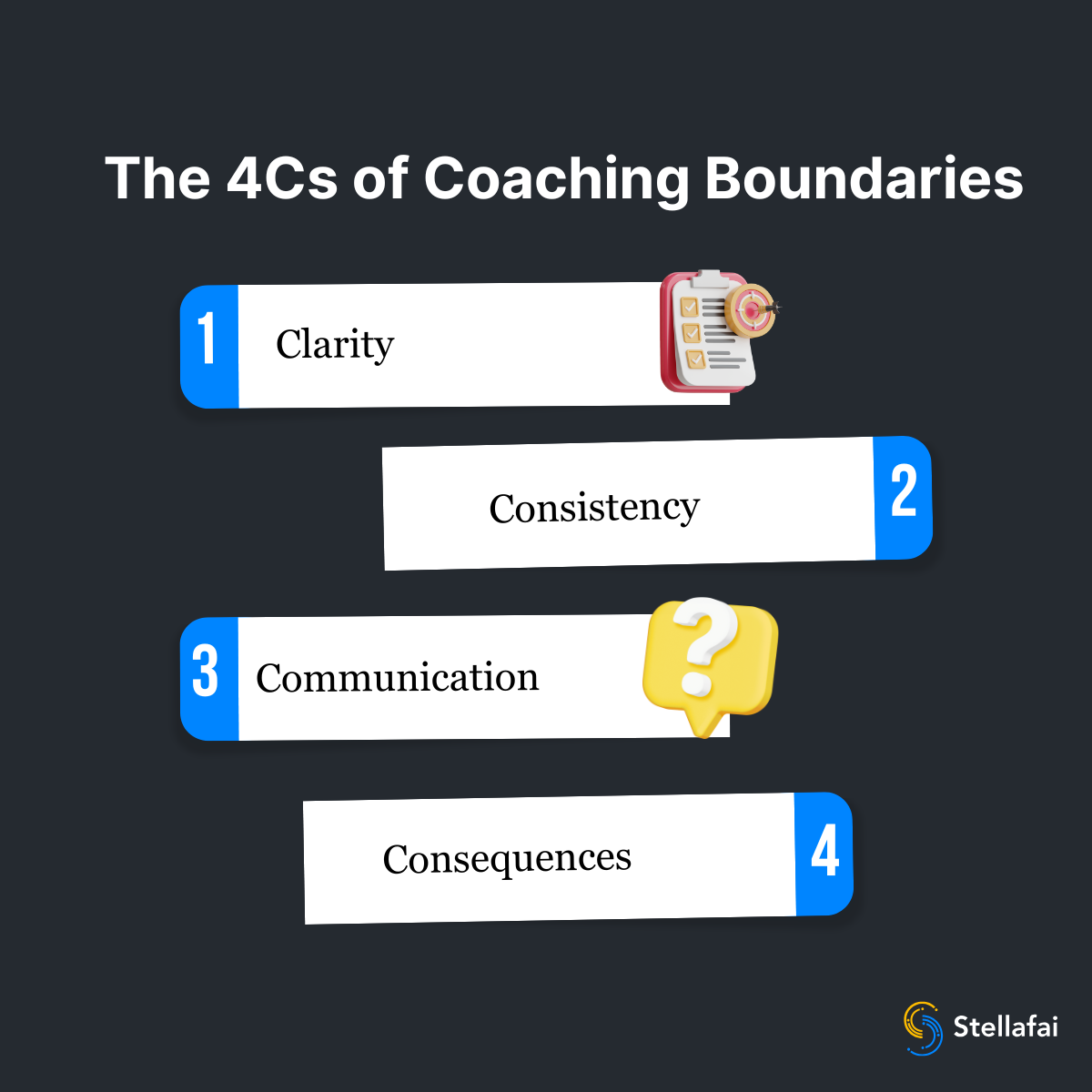Professional boundaries aren't barriers that keep clients at arm's length; they're the foundation that allows coaching relationships to thrive. When implemented thoughtfully, boundaries create clarity, respect, and sustainable coaching practices that benefit everyone involved.
In this article, you’ll learn proven strategies for setting professional coaching boundaries while maintaining strong client relationships.
Why are coaches scared to set boundaries with clients?
The answer is simple. The fear of losing clients is what drives coaches to become overly available, and in the long term, this leads to burnout.
Research in organizational psychology shows that clear expectations actually increase satisfaction in professional relationships. When clients understand how you work, they experience less anxiety about the coaching process and can focus entirely on their development goals.
The other common psychological barriers coaches face include:
- Fear of client abandonment: Worrying that boundaries will drive clients away
- People-pleasing tendencies: Feeling guilty about saying no or setting limits
- Imposter syndrome: Believing they don't deserve to set professional standards
- Confusion about service quality: Thinking availability equals excellent coaching
Understanding this psychological dynamic is very important for coaches who want to maintain high-quality relationships while protecting their professional sustainability.
Why You Should Set Up Sustainable Boundary Practices
Professional boundaries aren't just personal protection measures; they're essential business practices that ensure long-term coaching sustainability. With a well-communicated boundary, you’ll experience a higher client satisfaction due to predictable, professional service.
There will also be increased referrals from clients who respect your professionalism. Of course, this leads to reduced burnout and you setting up scalable practices that can grow without you compromising your quality.
How to identify when a client is violating your boundaries
Recognizing early signs of boundary violations can help coaches address issues before they become bigger problems. Also, by seeing these signs early, you can implement the 4Cs of boundaries. Some of the signs to look out for include;
- Clients consistently arrive late to sessions
- Frequent "urgent" messages for non-urgent matters
- Attempts to extend sessions beyond scheduled times
- Requests for personal favors unrelated to coaching
- Pushing back against established policies or procedures
The 4 C's of Boundaries in Professional Coaching, and how to implement them
The 4 C's of boundaries provide a comprehensive framework for establishing professional limits that support both coach and client success. This systematic approach ensures that boundary-setting becomes a preventative measure rather than a reactive one.

1. Clarity: Your clients should never have to guess when you're available or how quickly they can expect responses. Clarity means being explicit about:
- Response timeframes for different types of communication
- Emergency contact protocols and what constitutes an emergency
- Session policies, including start times, duration, and preparation expectations
- Payment terms and scheduling procedures
2. Consistency: Maintaining your established boundaries regardless of external pressures or individual client requests builds trust and professionalism. Consistency involves:
- Honoring stated response times even when it's inconvenient
- Starting and ending sessions at scheduled times
- Applying policies equally to all clients
- Maintaining boundaries during challenging periods
3. Communication: The way you present your professional limits significantly impacts how clients receive them. Effective boundary communication includes:
- Framing limits as service enhancements rather than restrictions
- Explaining the reasoning behind your operational structure
- Using confident, warm language when discussing boundaries
- Addressing questions or concerns with patience and clarity
4. Consequences: Well-designed consequences protect the coaching relationship while reinforcing the importance of mutual respect. Natural consequences might include:
- Ending sessions at scheduled times regardless of late arrivals
- Referring urgent non-coaching matters to appropriate professionals
- Requiring advance notice for session changes or cancellations
- Pausing coaching relationships when boundaries are repeatedly violated
How Stellafai Can Help You Set Professional Boundaries as a Coach
Stellafai is an outcome operating system designed to help you stay focused on impact while protecting your energy and time. Here’s how it can help you support healthy boundaries while keeping your clients happy.
Asynchronous Coaching
With Stellafai, you can provide asynchronous coaching services to your clients. So instead of juggling texts, emails, and DMs, they can leave messages or questions on the Stellafai platform. When you get the time, you can leave them a recorded message. This keeps your communication with clients even more organized and documented.

It also reduces off-hours messages because you can gently reinforce business hours with the time you respond. You still offer continuous support without the 24/7 availability expectation. Plus, since it's documented, you can better track client progress and insights over time.
Set up method libraries and practices
Stellafai also provides a section in your coaching space where you can set up either video or print libraries explaining key coaching concepts and techniques. This translates to scalable support systems that serve clients without requiring constant direct intervention.

You can also add resources, recommendations, and even external tools. Some coaches currently use these spaces to set up worksheets for specific challenges and goal-setting exercises. See how other coaches are using Stellafai.
Automated Scheduling Systems
You can also set up your calendar by adding a link on Stellafai so clients can book coaching sessions when it's convenient. Here’s how we currently do this for some of our coaching clients.

This presents your availability windows and eliminates and back-and-forth. To reduce no-shows, you can also ensure your cancellation policies are clearly stated and enforced.
Visible Progress Tracking
When clients can see their goals, progress, and milestones inside Stellafai, they’re less likely to derail sessions with unrelated concerns.

The platform encourages your sessions to focus on their goals and your agreed-upon role. This helps with more productive sessions and fewer requests outside of your agreed-upon scope.
Want to see more ways Stellafai can help? Book a free discovery session here.
Other ways you can set and keep boundaries with clients
When you present boundaries as your commitment to providing excellent coaching rather than limitations on client access, the entire dynamic shifts from restriction to service excellence. This reframing transforms potentially difficult conversations into opportunities to demonstrate professionalism.
Consider these messaging examples:
Instead of: "I don't check emails after 6 PM because I need personal time."
Try: "I maintain specific communication hours to ensure you receive thoughtful, well-considered responses rather than hurried replies."
Instead of: "I can't extend our session because I have another appointment."
Try: "Our 50-minute focused session allows us to dive deep into your challenges while ensuring I'm fully present for our entire time together."
The key lies in consistent messaging that connects your operational structure to client outcomes. When clients understand how your boundaries contribute to their success, they become partners in maintaining those limits.
How to Deal with Difficult Clients as a Coach
Challenging client behaviors often stem from unclear expectations rather than intentional disrespect. Most boundary violations occur when clients don't fully understand the professional framework or haven't experienced consistent boundary enforcement.
Assessment Questions for Difficult Situations
Before labeling a client as "difficult," consider these factors:
- Have you clearly communicated your boundaries and expectations?
- Have you consistently enforced your stated policies?
- Does the client understand the reasoning behind your operational structure?
- Are there external stressors affecting the client's behavior?
- Is there a mismatch between client expectations and your coaching style?
Response Strategies
When genuine boundary challenges arise, respond with calm professionalism:
- Acknowledge concerns while maintaining professional limits
- Refer back to agreements made during initial conversations
- Explain consequences calmly and without emotion
- Offer alternatives that work within your established framework
- Consider referrals when there's a fundamental mismatch
Wrapping up
Setting and maintaining professional boundaries isn’t just about protecting your time; it’s about preserving the quality of your coaching and the integrity of your business.
Stellafai gives you the structure, tools, and clarity to create those boundaries with confidence and consistency. If you're ready to build a practice that's both impactful and sustainable, book a free demo call here to get started.



.png)
.png)
.png)